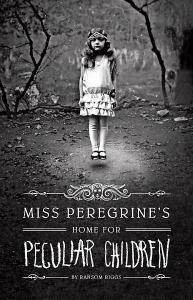Full disclosure: I read this one on my kindle and I stole this picture from Google. Until I get the new Paperwhite for Christmas, the screen on my Fire is too glare-y for taking photos, and I know none of you care about seeing my teal kindle case yet again. Also, a great deal of the eerie-ness of Ransom Rigg’s Miss Peregrine’s Home for Peculiar Children is encompassed in the photographs he includes, of which the cover is one of the best.
 See, isn’t this design fantastic? And it fits perfectly with the aesthetic and tone of the rest of Rigg’s debut novel. I didn’t really know what to expect when I first started reading it, but a lot of the first impressions I gleaned from the cover held true. So let’s talk about the plot.
See, isn’t this design fantastic? And it fits perfectly with the aesthetic and tone of the rest of Rigg’s debut novel. I didn’t really know what to expect when I first started reading it, but a lot of the first impressions I gleaned from the cover held true. So let’s talk about the plot.
I suppose I would categorize this one as a young adult book (the Internet tells me it’s a children’s chapter book, but I respectfully disagree). It centers on Jacob Portman, a 16 year-old boy who, after discovering his grandfather’s mangled body in the woods behind his home, travels to Wales in order to find out about the mysterious past his grandfather always referenced before his death. Once he arrives Jacob finds himself in a time “loop” with a group of “peculiar” children that are, on average, 80 years old. The children each have a special talent or skill, such as invisibility or levitation. In order to guarantee their safety from the malevolent forces that want to kill and eat them (yes, seriously), their guardian has used her exceptional powers to create a sort of never-ending day from the 1940s. This day is during WWII, a time when all of the children were living with Miss Peregrine in the home that is the novel’s namesake. This, as I mentioned, enables them to stay hidden from “hollowgasts,” the monsters that killed Jacob’s grandfather, Abe. Oh, and did I mention that Abe was peculiar also, and lived with Miss Peregrine and the children after his family was murdered by the Nazis? A bit dark to be considered just a “chapter book,” if you ask me.
As far as style goes, I appreciate what Riggs does. He deals with such complex and frightening themes by having his narrator, Jacob, describe them as a typical 16 year-old would, complete with slang and dirty jokes. At times it got a bit too corny for me, but I understand the need for this method. However despite Jacob’s occasionally annoying tone, I got incredibly creeped out while reading the book, especially at night. There are a series of black-and-white photographs that Riggs includes sporadically throughout the plot; they are seriously creepy and always managed to catch me off-guard. The cover photo above is a mild indication of what some of the others are like.
I found the story told in Miss Peregrine’s to be exceedingly well-done and well-explained, especially considering how much trouble I had just summarizing the basics of the plot for this post. I was rarely confused and constantly interested. Riggs builds suspense and writes action well, and is able to blend crime with fantasy and horror and history in quite a seamless way. It’s the first horror-adjacent (I just made up that genre) novel I’ve read in a long time, and I enjoyed it a lot.
The book reads incredibly quickly and embraces the best aspects of all the genres it blends together. Overall, it was a great read, despite the “young adult” or “chapter-book” label. Some of the best books are written for people younger than me, and I know I’ve ranted about YA stigma before, but I’m a firm believer that if you were ever or ever plan to be the age of the characters in a book, there’s something for you to learn (and enjoy) by reading it. Miss Peregrine’s is no exception.
